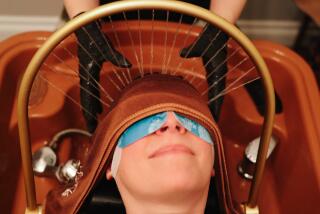New-Age Treatments for the Four-Legged Set
DENVER — Brooke Front was weary.
Unsteady on his feet, his back drooped with stress from a long day at the Rocky Mountain Horse Expo until owner Bill Bormes dragged his thumb sharply along the chestnut show stallion’s spine, releasing tension and righting posture.
Bormes said he learned the acupressure technique from a veterinarian. “I just make a mild adjustment and Brooke’s posture is back to being near perfect,” he said.
Techniques such as acupuncture, acupressure and chiropractic treatments are becoming mainstream tools used to complement Western medicine in animal care, veterinarians say.
The number of vets involved in the International Veterinary Acupuncture Society has grown substantially from about a dozen to more than 1,400, spokesman Ed Boldt said. Formed in 1974, the Fort Collins, Colo.-based nonprofit teaches acupuncture courses and aims to create uniform international standards.
“We used to be the only place that offered courses in acupuncture, but now there are a bunch of schools offering classes,” Boldt said. “That’s a great sign.”
Among them: Tufts, Cornell, and Texas A&M; universities.
Acupuncture is designed to relieve pain or induce regional anesthesia by inserting needles into specific points of the body. It is also used to stimulate nerve function, hormone levels and blood circulation.
Dr. Narda Robinson, who performs acupuncture on animals at Colorado State University, said most patients suffer from muscular and skeletal pain, and head and neck pain.
“After we insert a needle into the body, there is a profound relaxation. Horses will start licking their lips, letting their heads drop down and dogs will lie down and sleep,” she said.
Acupressure and chiropractic techniques used on people have similar effects on animals. Vets use their hands to perform massage-like movements geared toward releasing endorphins and relieving muscle spasms.
Robinson recently treated a 5-year-old champion German shepherd named Sepp, who was suffering from a strained ligament that affected his showmanship. With acupuncture treatments, Sepp was able to overcome the lameness in his leg.
Colorado State horse expert Gayle Trotter said the best candidates for chiropractic work are horses with chronic back problems caused by their daily routine.
“We don’t have tools to treat certain problems, and some animals just won’t get better. This helps ease the pain,” he said.
Trotter stands on a stool while he carefully works to adjust a horse’s limb. Gentle movements calm the animals and make them more receptive to treatments.
Trotter said some vets are skeptical about the effects of chiropractic care, though most of the animal caretakers are pleased with the results.
“If I look at an animal and find a problem, I will do whatever I need to get the problem corrected,” Trotter said.
Some horse owners say the techniques are frivolous.
Jackie Dunn, who trains mustangs at stables near Elbert, about 40 miles southeast of Denver, said her animals don’t need the treatments because she already cares for their muscular pain by making sure saddles aren’t too tight, and by rubbing them down after they are worked.
“It’s just not an issue for my animals,” she said. “I try to make sure they aren’t overworked.”
Veterinarian Steve Long, who’s been in practice in Golden, Colo., for more than 20 years, said acupuncture can be helpful in some cases, but it shouldn’t be expected to replace traditional medicine.
“It does some good, but only in specific cases,” he said.
Long doesn’t perform the treatments, but sends some patients to acupuncturists.
“It’s not that it wouldn’t be nice to learn how it works, but it’s hard enough keeping up with all the regular tools we need to know.”
Robinson and Trotter stressed that the techniques are used to complement other medical procedures and cannot replace surgery.
Robinson started the university-based veterinary acupuncture course at Colorado State in 1998. Since then, about 60 vets per year from all over the world take the course, which reviews anatomy of the acupuncture points and teaches students how to insert needles.
More to Read
Sign up for Essential California
The most important California stories and recommendations in your inbox every morning.
You may occasionally receive promotional content from the Los Angeles Times.










